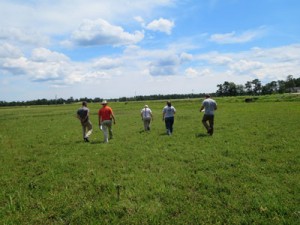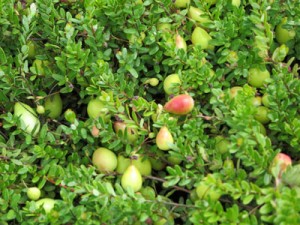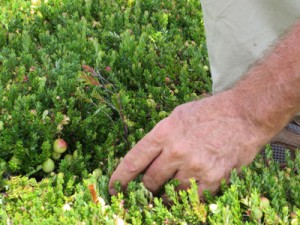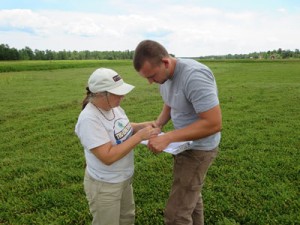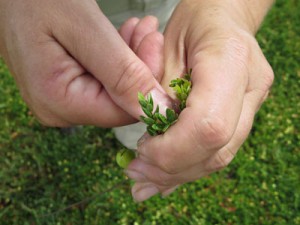This week we once again hosted Dr. Joan Davenport of Washington State University. Joan, a former researcher for Ocean Spray, works with Pine Island Cranberry to provide guidance on fertilizer, water, and nutrients, as well as general PIICM management. Joan comes to see us in the spring during the bloom period and again in the height of summer to discuss fertilizer needs for bud set (defined below).
Additional nutrition is necessary because while cranberries have adapted (and thrive) in their native sandy soil, nutrients are taken from the bog through the harvest of fruit. The three main elements usually added for nutrition are nitrogen, phosphorus, and potassium. According to cranberries.org: “Cranberry plant demand for nitrogen is highest during three stages of the lifecycle critical to cranberry development–early growth, fruit set and bud set. Early growth is when the plant grows vegetatively through vining and root growth and produces a flush of new leaves. Fruit set is when the flower becomes pollinated and fruit begin to form. Soon after fruit set comes bud set when nitrogen is needed for both fruit development and production of the next year’s flower bud.”
Joan and our PIICM team visit several bogs to check growth and fruit set in order to best determine nutritional needs. They also take into account the sanding schedule, as sanding helps improve growth and yield by stimulating the development of new uprights (covering the base of the roots strengthens the root system and creates a more healthy vine) while also reducing insects (by burying insect eggs) and improving soil drainage. This lowers the need for additional plant nutrition.
“This late in the growing season, we are assessing the new plantings for nutritional needs but also for when to stop fertilizing, so that the plants will enter dormancy,” Joan says. “For established beds, we are evaluating the plants for how much crop they are holding and the bud potential for next year to develop recommendations for applications for the remainder of the growing season, including post-harvest and some guidance for roughneck in the spring of next year.” (The roughneck stage is when the stem elongates significantly and all flower buds are visible, being held tight to the stem.) To do this, Joan and the PIICM team look at the amount and size of fruit, the length and color of both new and upright growth, and the amount of buds already set.
Once Joan and the team tour the bogs, she makes specific recommendations based on their findings, such as the sand level needed in certain beds or where to adjust for deficiencies.
“It’s going to take eyes on the beds,” Joan says. “But here, there are always eyes on the beds.” And as always, our PIICM team is out doing whatever it takes to make sure our growing season gives us good results.
Sources:
1. Fertilizer Use in Cranberry Production: http://www.cranberries.org/pdf/soil_fertility.pdf
2. Workmaster, Beth Ann A., Jiwan P. Palta, and Teryl R. Roper, “Terminology for Cranberry Bud Development and Growth”, http://longbeach.wsu.edu/cranberries/documents/terminologyforcranberrybuddevelopmentandgrowth.pdf

